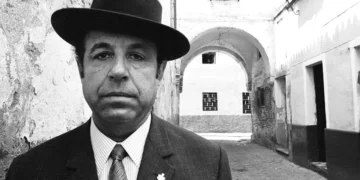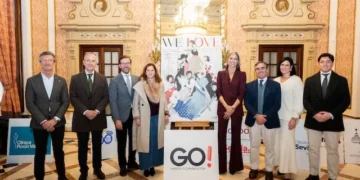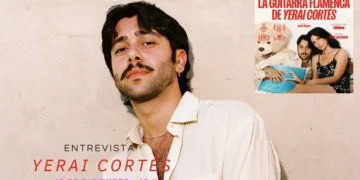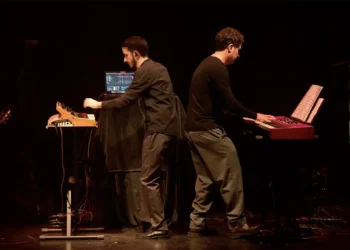|
Valle
| Daily coverage BIENAL DE FLAMENCO sponsored by: |
Dorantes: piano. Violoncello quartet: Gretchen Talbot, Richard
Eade, Robert Thompson, Claudio Baraviera. Guest artist: Lole Montoya.
Cante: José Valencia. Turkish sax, flute: Nacho Gil. Double
bass: J. Manuel “Popo”. Indian tablas: Keshab Canti
Showdhury. Percussion: Tete Peña. Palmas: El Chícharo,
Vicente Peña.
Sounds of Dorantes
David Peña appeared once again at the Bienal displaying
his soul at the piano. After his success at the last edition it’s
not easy to face an audience that hasn’t forgotten. The challenge
is tremendous and audience expectations with just over half the
theater filled, must be satisfied. He’s the only one responsible
for people gathering during intermission and agreeing that despite
the undeniable beauty of what was offered, it hadn’t matched
the quality of the former show , “Sur”, whose memory
still warms the ancient walls of Seville’s Reales Alcázares,
the fabulous venue not included in this year’s Bienal.
The young man from Lebrija began the recital thoroughly into himself.
He seems to reject the mere repetition of a set repertoire and isn’t
quite at ease. Inspiration starts to flow and he plays some of his
well-known compositions in a straightforward way. Giving his all
now, he caresses the piano and there’s a secret dialogue with
the instrument. “Oleaítas mare”, “La danza
de la sombras”, “Sur”…sounds of Dorantes.
You can feel the progression as the musician continues to warm up.
David’s virtuosity can’t be ignored and his ability
to compose is obvious in the pieces he interprets and in the ones
he wrote for the violoncello quartet that participates in the second
part of the show.
He premieres the piece “Ragazos” with its counterpoint,
silences, the ebb and flow, touching the piano keys as he would
a lover. “Por bulería” finishes off the first
part and he reaches into the piano to touch the strings which he
strums like a guitar to play a variation of Diego del Gastor. José
Valencia sings and Chícharo does his little dance with all
the naturalness in the world, his art shining through in his smile.
Three movements for violoncello: the first based on seguiriya,
the second melancholic and the third evoking mechanical sounds.
Dorantes is only present in the sheet music…he’s behind
the scenes creating new music. He not only interprets and composes
for piano, but can and does also write for other instruments because
he has the preparation and background. And in no way does this diminish
his worth in a world that idealizes the musically illiterate and
those who learn by ear (is there really any other way?), at informal
gatherings and fiestas (he has surely seen his share), or through
his family (long live the Peña family!). David Peña
combines all the qualities that make him a top-notch musician as
well as a true flamenco. The perfection of his touch and the arabesques
he explores sound classical at times. At other moments there’s
more of a jazz sound. And guitar, although it isn’t exactly
a guitar, Dorantes is one of the pianists whose playing most approximates
the sound of a guitar. He has his own identity with the instrument,
it’s not an imitation of the guitar.
José Valencia gets going with the ‘romance’
“Bailar sobre la mar” and Dorantes dedicates the piece
to his father who recorded it years ago. Charming. Lole appears
on stage to a warm ovation – with her sweet clear voice she
sings “La Maza”. This is followed by percussion dialogues
with the Hindu tabla-player Keshab Canti Showdhury. More music:
mood music for dreams. The evening finishes off with all the performers
on stage and a bulerías curtain call. Lole dances barefoot
and from the audience a branch of rosemary is cast towards Dorantes
symbolizing good luck. A thoroughly delightful show which might
have been even more delightful with a bit more flamenco.
“La cava de los gitanos”
Curro Fernández y familia
“La familia de los Moneos” Manuel Moneo y familia
Saturday, 25th september, 2004. 2400h. Hotel Triana, Seville
Texto : Estela Zatania
Familia Fernández
Cante: Curro Fernández, Pepa Vargas, Ismael Fernández,
Salvador “El Fragüero”, Pepe “El del Altozano”.
Dance: José Fernández, Soraya Fernández. Guitar:
Paco Fernández, Miguel Pérez. “The new sap”:
Diego Cortés, María Cortés, El Bola, Samara
Fernández, Dieguito “El Churri”, Miguelito Fernández,
Soleá Fernández, Curro Vargas, Francisco “El
Cama”.
Familia de los Moneos
Cante: Manuel Moneo Lara, Manuel Moneo “El Barullo”.
Cante and dance: Macarena Moneo, Rocío Moneo, Chico de Pacote,
Antonio Carpio. Guitar: Juan Moneo, Manuel Moneo “El Barullito”.
The last scheduled night at the Hotel Triana of this Bienal
de Sevilla ended with a healthy dose of traditional flamenco with
the families of Curro Fernández from Triana, and Manuel Moneo
from Jerez.
With a theatrical flourish, projected images of old Triana and
a forge complete with fire and bellows a narrator tells the history
in a nutshell of the Cave de Triana, the smithies, the gypsy families
and the cantes they cultivated. Veteran singer Curro Fernández
sings a martinete, Jerez dancer Soraya Clavijo interprets a short
siguiriya with her customary good taste and respect for the best
traditional style dance, and José Fernández surprises
the audience with his original take on bulerías. Soraya returns,
more bulerías, soleá por bulerías and the first
part ends with “The new sap”, a group of youngsters
with “too much” artistry for their age.
After intermission the Jerez dynasty of the Moneos takes over the
stage, eleven individuals in all, “singing for la Paquera”
as a voice announces. Barullo sings bulería por soleá
including the odd cante of Carapiera in major key, followed by fandangos.
His sister Macarena offers her customary festive repertoire with
a voice that’s sounding more flamenco as the years pass, and
patriarch Manuel Moneo rounds things out with soleá and siguiriyas,
not without first declaring “Between the gypsies of Triana
and the gypsies of Jerez, flamenco cante will not be forgotten”.
|
|
Related products:
|
|
|
|

























